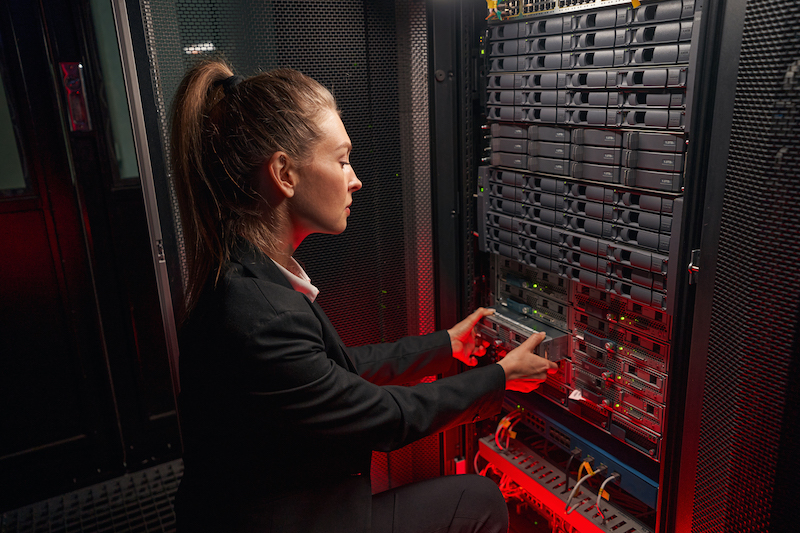Your IT Infrastructure is a key component of your business. An out-of-date or low-quality system can create inabilities and have a decreased effect on productivity, efficiency and work flow. EC Managed IT understands that a network must be prepared to meet the demands of emerging technologies and cloud integration.
We have examined the following signs to look out for, indicating that it’s maybe time for an IT Infrastructure upgrade:
You’re Using Old Computers
Things just don’t last like they used to—your company computers are no exception. The desktop and laptop computers you invested in years ago were probably great when you got them but are now lagging behind, freezing or crashing, causing you more frustration than getting work done. When you think of IT infrastructure you probably think about servers and other networking tools but your computers’ itself are just as important! Replacing those old computers is a great opportunity to invest in the next generation of devices with greater capabilities.
Investing in tablets and other hybrid devices can also give your staff updated tools that will offer them better flexibility and cost-effective access to the newest technology. As Microsoft and Lenovo Gold Partners, Intel, Acer, HP, IBM… and more, EC has access to major manufacturers to get your computers updated and running on the best platforms suited to your company.
Your Software is Out of Date
Software that is approaching its end of life is more than just slow and out of date, it can actually put your entire network at risk. Although your staff is probably comfortable with it and change in learning new software is always challenging; out-dated software is more susceptible to viruses, malware, and cyber attacks than new software. Old software is also in danger of non-compliance with regulated industry standards. Our team at EC can help train your organization upon new software deployment.
Updating your software is a key IT infrastructure upgrade. New software can potentially benefit your business in the following ways:
- Increased Security
- Increased Capabilities
- Improved Productivity
- Better Efficiency
- Lower Long-Term Costs
Inconsistent Hardware
As your company and team have most likely grown over the years, you’ve probably had to add new hardware. That means your employees are using a wide range of different computers and other tools across the board. Inconsistent hardware can lead to problems communicating and collaborating. Because compatibility is a key aspect of a smooth running business, you need to ensure your employees are using hardware that easily syncs, shares documents, runs the same software, and can be easily controlled and managed by one system.
As you begin your IT infrastructure upgrade, focus on selecting & deploying hardware that is compatible and syncs together enabling seamless sharing and collaborating functions.
Your Systems Are Slow
There’s nothing more frustrating than staring at a spinning wheel on your computer screen. A slow application is not only just annoying but it slows down your entire team and essentially your entire business.
Slow systems may be a symptom of a deeper, underlying issue in the IT infrastructure of your company. This root cause could be inadequate storage, lack of processing power, or limited bandwidth. An IT infrastructure upgrade will address these issues to help you deliver lightning-fast systems. Fast applications mean a more efficient business, and a more efficient business means higher levels of productivity.
Not Enough Storage Space
If you’re running out of storage space you’re in desperate need of an IT infrastructure upgrade. Limited storage space can lead to slow systems and server crashes.
If you run out of storage space your may not be able to save important documents and face the possibility of losing highly valuable company data causing a potential decrease in your organizations’ productivity. Migrating data storage to the cloud is a cost-effective and efficient option. Cloud storage is infinitely scalable and can be added much quicker than traditional storage that requires purchasing, formatting, and installing additional servers and storage drives.
You’re Not Using the Cloud
Cloud computing is revolutionizing the way business is conducted. That’s because cloud computing offers increased flexibility, scalability, and collaboration. What’s more, cloud computing can help you get your entire staff on the same software.
If your staff is using a mix of operating systems, the cloud will enable everyone to work with the same current, updated software.
If your organization isn’t taking advantage of the cloud, it’s time for an IT infrastructure upgrade. EC just so happens to specialize in Cloud Computing and Microsoft Migrations. Moving onto the cloud will not only give you the increased processing power and data storage your company needs, but it will also give your employees the consistency, flexibility, and improved collaboration tools to help you get the most from your technology.
You’re Paying Too Much
The older the technology, the more it costs to update and repair it. Over the years, the costs of maintenance and repairs start to add up. Your IT systems also require the use of energy. Typically the older the technology, the hotter your hardware runs, impacting your energy costs. Your costs shouldn’t be stacking up just to keep your systems up and running.
Many organizations tend to use quick fix measures to deal with IT issues, but don’t address the deeper, underlying causes. A full IT infrastructure upgrade will end up saving you more money in the long run.
You Don’t Have Reliable Backups
Does your company have a solid backup plan in place? Unfortunately, the answer for many organizations is no. Without a reliable backup plan your company is at risk for data loss in the event of disasters, breach’s, or power outages.
Your business should consider working out a full data recovery plan that includes regular backups and testing. EC recommends the 3-2-1 back rule which is keeping at least three copies of your data, storing two backup copies on different storage medias, and one of them located offsite. Cloud hosting is a smart way to store full data backups at multiple geo-locations. This gives your company the protection it needs to withstand a disaster or loss of primary systems.
Don’t wait until it’s too late to worry about data backups and disaster recovery plans. Be proactive with your IT & data, prevent the fires from starting rather than putting them out afterwards.
Your Systems Was Breached
There is no clearer sign you need to upgrade your IT infrastructure than a security breach. A successful cyber attack can damage your organization’s ability to conduct business, impair your status as a reliable business partner, and even put your company at risk of closure. Even if the attack had minimal impact, what’s to say there won’t be another happening with your current IT infrastructure state.
If your systems are breached you need to complete a full systems check, replace old hardware, update software, and improve your security measures. EC is here for you and your organization. We can provide a full network assessment and provide proactive cybersecurity services where needed.
…
Contact EC to assess your IT infrastructure and Networks today!




